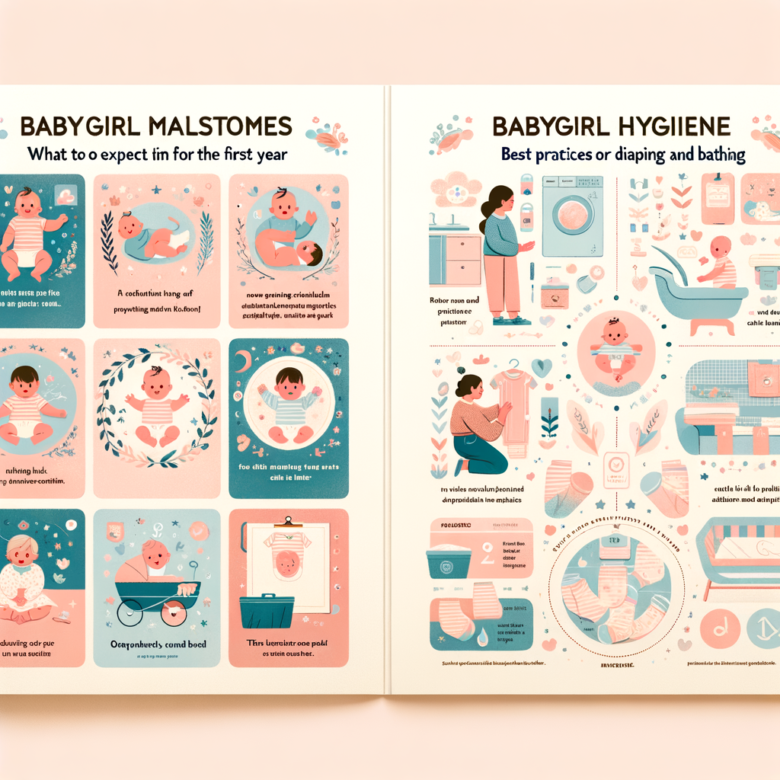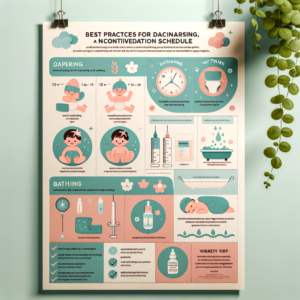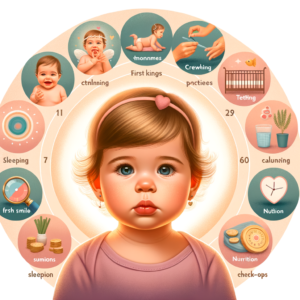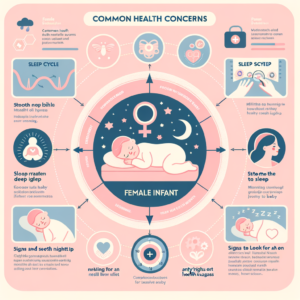Maintaining proper hygiene for your babygirl is crucial for her health and comfort. This comprehensive guide will cover best practices for two essential aspects of baby hygiene: diapering and bathing. By following these guidelines, you can help keep your little one clean, comfortable, and healthy.
Part 1: Diapering Best Practices
Proper diapering is essential to prevent diaper rash and keep your babygirl comfortable.
Diaper Changing Essentials
Before you start, gather these supplies:
- Clean diapers
- Wipes or warm water and soft cloth
- Diaper rash cream
- Changing pad
- Diaper pail or disposal bag
Step-by-Step Diaper Changing Process
- Prepare the area:
- Lay out a clean diaper and supplies
- Place your babygirl on a clean, safe changing surface
- Remove the soiled diaper:
- Unfasten the diaper tabs
- Lift your baby’s bottom by gently grasping her ankles
- Remove the soiled diaper
- Clean the diaper area:
- Use wipes or a damp cloth to clean from front to back
- Pay attention to skin folds
- For girls, always wipe from front to back to prevent UTIs
- Apply diaper cream:
- If needed, apply a thin layer of diaper rash cream
- Put on a clean diaper:
- Slide the clean diaper under your baby
- Fasten the tabs snugly but not too tight
- Dispose of the soiled diaper:
- Roll up the soiled diaper and secure with its tabs
- Place in a diaper pail or disposal bag
- Clean up:
- Wash your hands thoroughly
- Clean the changing surface
Diaper Rash Prevention and Treatment
- Change diapers frequently
- Allow some diaper-free time daily
- Use fragrance-free wipes or just warm water
- Apply a barrier cream at each change if prone to rash
Part 2: Bathing Best Practices
Bathing your babygirl is not just about cleanliness—it’s also a bonding experience.
Bathing Essentials
Gather these supplies before bath time:
| – Baby bathtub or clean sink |
|---|
- Warm water
- Mild, tear-free baby soap
- Soft washcloth
- Hooded towel
- Clean diaper and clothes
How Often to Bathe
- Newborns: 2-3 times a week
- Older babies: Daily baths are fine if enjoyed, but not necessary
Step-by-Step Bathing Process
- Prepare the bath:
- Fill the tub with 2-3 inches of warm water (100°F or 38°C)
- Check water temperature with your wrist or elbow
- Undress and place baby in the tub:
- Support her head and neck at all times
- Never leave your baby unattended in the bath
- Wash her body:
- Start with the face, using plain water
- Gently clean each part of the body with the washcloth
- Pay attention to skin folds
- Wash her hair:
- Wet her hair with a damp washcloth
- Apply a small amount of baby shampoo
- Gently massage the scalp
- Rinse thoroughly, protecting her eyes
- Rinse:
- Use a cup or your hand to rinse soap off completely
- Dry and dress:
- Lift her out carefully, supporting head and neck
- Wrap in a hooded towel
- Pat dry gently, paying attention to skin folds
- Apply lotion if desired
- Diaper and dress
Special Considerations for Newborns
- Sponge baths until umbilical cord stump falls off
- Be extra gentle around the umbilical area
- Keep the umbilical area dry
Hair and Scalp Care
- Wash hair 2-3 times a week
- Use a soft brush to prevent cradle cap
- For cradle cap, apply baby oil before shampooing
General Hygiene Tips
- Nail Care:
- Trim nails when baby is calm or sleeping
- Use baby nail scissors or a file
- Ear Care:
- Clean outer ears with a damp washcloth
- Never insert anything into the ear canal
- Eye Care:
- Wipe eyes from inner corner outward with a damp cloth
- Use separate areas of the cloth for each eye
- Oral Hygiene:
- Before teeth emerge, wipe gums with a soft, damp cloth
- Once teeth appear, use an infant toothbrush with a tiny smear of fluoride toothpaste
Frequently Asked Questions
Q: How do I clean my babygirl’s genitals? A: Gently clean the outer areas only, wiping from front to back. There’s no need to clean inside the vagina.
Q: Is it necessary to use soap every bath time? A: No, water is often sufficient. When using soap, choose a mild, fragrance-free option.
Q: How can I make bath time more enjoyable for my babygirl? A: Use bath toys, sing songs, and maintain a positive attitude. Make it a fun, bonding experience.
Q: How do I know if the bath water is the right temperature? A: The water should feel warm, not hot, on your wrist or elbow. Aim for about 100°F (38°C).
Q: How often should I change my babygirl’s diaper? A: Change diapers as soon as possible after they become wet or soiled, typically every 2-3 hours for newborns.
Conclusion
Proper hygiene practices are crucial for your babygirl’s health and comfort. By following these diapering and bathing best practices, you can help prevent skin irritations, diaper rash, and other discomforts while also creating positive, bonding experiences with your little one.
Remember, every baby is unique, and you may need to adjust these practices to suit your babygirl’s specific needs. Always be gentle, patient, and attentive to your baby’s cues during hygiene routines. If you have any concerns about your baby’s skin or hygiene, don’t hesitate to consult with your pediatrician.
With consistent care and attention to these hygiene practices, you’ll help keep your babygirl clean, comfortable, and happy throughout her early months and years.



